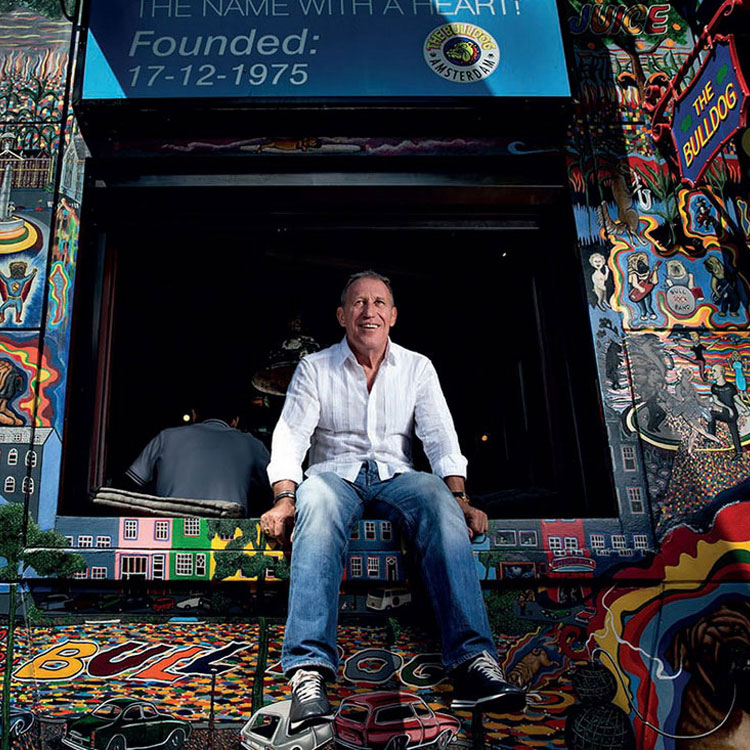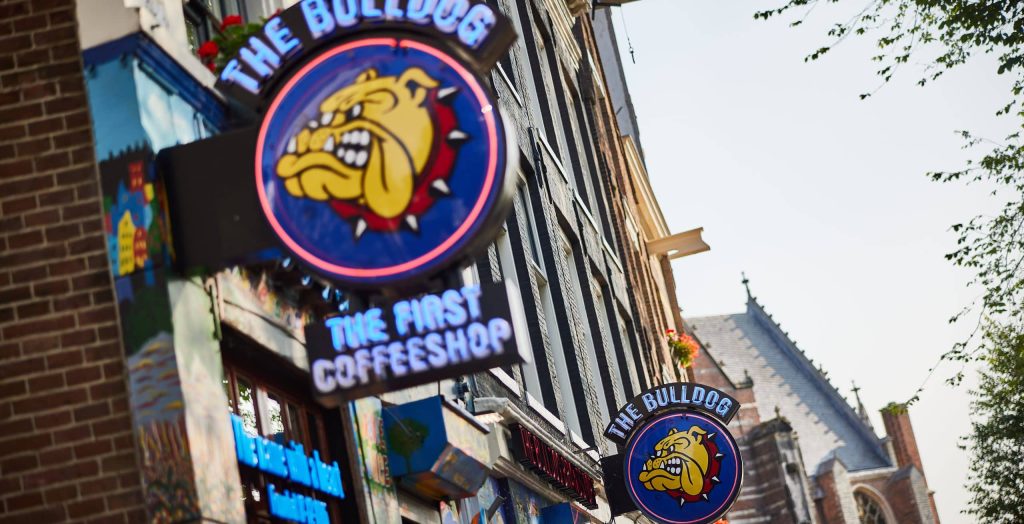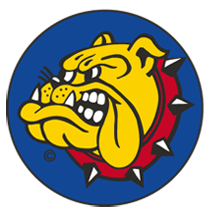- Worldwide shipping
- Discrete shipping
- From The Netherlands
- 30-day return policy
- Personal growing guide
About us
Since 1975
The Bulldog Amsterdam has been pushing cultural boundaries for almost half a century, pioneering the most significant Dutch social innovation in the past 50 years. Founded by Henk De Vries, The Bulldog has grown from the first coffeeshop to become a world-renowned cannabis brand with bar, hotel and restaurant locations in Canada, Spain, Italy and The Netherlands.
In 1975, The Bulldog became the first coffeeshop in the world, but how did it begin?

HENK & FRIEND
The story starts not in the Red Light District of Amsterdam but at a music festival called Kralingse Bos, Rotterdam, in 1970. Today music festivals are commonplace in the Netherlands, but until Kralingse Bos, music festivals were just something the Americans did, and it was still a relatively new phenomenon for them. The music lineup included Jefferson Airplane, Santana and The Byrds. The lineup in the 150,000-strong crowd included Henk, and his future long-time friend and Sensi Seeds founder, Ben Dronkers.
Henk had supplied his friends with more than enough grass to have a good time at the festival and was ready to enjoy the music he had travelled to hear. After a while, someone tried to sell Henk the same grass he had given his friends. Henk realised his friends had been doing business with the grass Henk gave them.
Angry but inspired, Henk realised he could sell the grass and do it better than his friends. Henk immediately travelled home to Amsterdam to pick up more than a kilo of African grass and matchboxes to put it in. He emptied the boxes of the matches before filling them with African grass and driving back to Rotterdam. Once back at Kralingse Bos Festival, Henk sat in the middle of a little bridge at the back and began selling his matchboxes of grass.
SELLING MATCHBOXES
Henk pitched on the bridge and quickly gained attention, not all positive. Two police officers informed Henk that what he was doing was illegal and that he was about to be arrested. Just as Henk was about to be taken to the police station, a tall man with long hair appeared and began to dispute the arrest. That man was Koos Zwart, the organiser of the Kralingse Bos. Koos won the debate and permitted Henk to sell his matchboxes on the bridge, and he also announced over the loudspeaker where Henk was sitting.
HENK'S FIRST EXPERIENCE
The Kralingse Bos Festival was Henk’s first experience selling cannabis with police approval, and how the police interacted that day gave a good indication of the Dutch tolerance policy that followed later in the decade.
Five years would pass before The Bulldog Amsterdam officially opened in 1975, but it was that day in 1970 that Henk sowed the seed for what the Bulldog is today. Kralingse Bos had such an impact on Henk that he would later decorate the walls of every Bulldog with copies of the posters from that day.
1974 GOODBYE PORNO
After spending a couple of years on holiday courtesy of the German government, Henk took over his Fathers sex shop in the Red Light District. Born and raised in the area, Henk knew what went on around there, but one day, one of Henk’s customers was not satisfied with the selection in the shop and made some disturbing requests. Utterly disgusted by what the customer was asking for, Henk asked them to leave before quickly deciding the sex shop business was not for him. Ever the businessman, Henk tried to return his stock, but the supplier offered only 10% of its worth. As a man of principle, Henk refused the insulting offer stating he would dump his stock in the canal rather than sell them back so cheaply, which is what he did. The seed sowed at Kralingse Bos was growing.
A LIVINGROOM WHERE FRIENDS COULD MEET
The idea of the first coffeeshop came to Henk because he liked the Dutch teahouses of the time. Teahouses were predominantly places where semi-unlawful activities such as illegal slot machines or selling beer without a license happened. Some teahouses had a house dealer who was not officially working for the teahouse but would sell hash there. The most famous example of this is Mellow Yellow. Once inside these semi-exclusive teahouses, you would drink tea for free but donate to the house dealer to buy and smoke hashish while you were there. Henk saw these tea houses and saw no reason why not to take it further and opened a shop selling cannabis over a counter to anyone (18+) who wanted to buy it.
Henk turned the celler sex shop at no.90 that sold porn into a living room where friends could meet and smoke.
“I wanted to make the connection with a teahouse. In my opinion, that was like a living room for neighbourhood residents. Some things which happened there were not allowed in other places, like selling beer under the counter and hiding a slot machine behind the curtain. I wanted to capture the teahouse feeling and keep the atmosphere of a living room. At the same time, I wanted to have an international character to the place, and that is how the term ‘coffeeshop’ was born.” – Henk De Vries.
Joris The English Bulldog
The first coffeeshop was born, and it needed a name. Henk wanted a name that was iconic, rebellious, social, humorous and authentic. Henk looked no further than his beloved pet dog, Joris. Joris was an English Bulldog, and Henk thought Bulldogs had all the characteristics he wanted in his coffeeshop, so he named it The Bulldog.

KNOWN AS NR.90
The Bulldog started selling cannabis in 1974 but did not officially open its doors of The Bulldog First until 1975.
The Bulldog First, affectionately known as the Nr.90 due to its door number, is still there today and proudly holds the title of the first coffeeshop and the longest-running coffeeshop with the same owner. In addition, The Bulldog holds the unofficial title for having probably the most colourful, creative and iconic coffeeshop front in all of Amsterdam. The basement of the former sex shop was a VHS cinema where people could buy cannabis and enjoy a movie in a living room atmosphere. Today and the VHS cinema is less used but still there, but the atmosphere is more welcoming than ever.


INFAMOUS RAIDS
At the time, Amsterdam was not quite as liberal as it is now. Selling cannabis was not allowed. In its first year, the police raided The Bulldog First up to 1000 times. 20 – 30 police officers would burst through the doors as many as five times a day to arrest customers and seize the stock. Undeterred by the punishment from the police – a small fine and a 30-minute stay at the police station – customers would return and get refunded with a new bag of cannabis from Henk.
The police raids became so infamous that tourists visiting The Bulldog hoped to be a part of the next one. The police kept trying to stop The Bulldog, but their efforts only brought more attention. The people kept coming, and so did the police, so Henk and his friends had to invent ways to keep the African grass from the police, leading to creative ideas involving stash stools and oranges.
House rules
Everyone was welcome at The Bulldog, but not everything was allowed. The Bulldog had house rules that are still enforced today. The possession and use of hard drugs are strictly forbidden.
DESIGNED AND PAINTED BY HAROLD THORNTON
Designed and painted by Australian expat and Henk’s friend Harold Thornton, A.K.A Harold Kangaroo. Known as the greatest painter that ever lived, Harold was famous in Amsterdam, and Henk asked him to paint the sign of The Bulldog Nr.90. Harold turned the what was supposed to be reasonably sized sign into the now famous mural covering the whole front of The Bulldog. The mural has helped attract countless backpackers to The Bulldog and is a must-see sight for any visitor to Amsterdam.
Pushing cultural boundaries since 1975, we aim to maximize the growth of your plants with our exclusive range of seeds. We strive to offer home growers the best experience possible, ensuring the highest sprouting rates and reliable yields.
To provide the best experiences, we and our partners use technologies like cookies to store and/or access device information. Consenting to these technologies will allow us and our partners to process personal data such as browsing behavior or unique IDs on this site and show (non-) personalized ads. Not consenting or withdrawing consent, may adversely affect certain features and functions.
Click below to consent to the above or make granular choices. Your choices will be applied to this site only. You can change your settings at any time, including withdrawing your consent, by using the toggles on the Cookie Policy, or by clicking on the manage consent button at the bottom of the screen.
The Bulldog seeds


The Bulldog Seeds are strictly sold as souvenirs. You are prohibited from taking these seeds to countries where possession of and/or trade in cannabis seeds is illegal. We dispatch our seeds on the condition that the seeds will not be used in conflict with applicable law. By entering this site you agree to our terms and conditions, privacy and cookie policy.
Sorry, you must be 21 or over to enter this website.